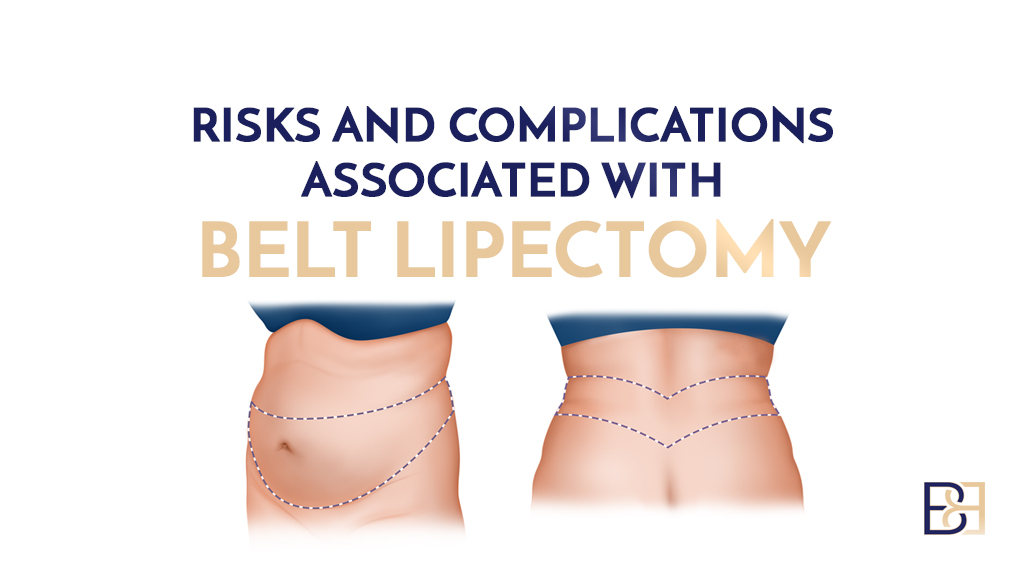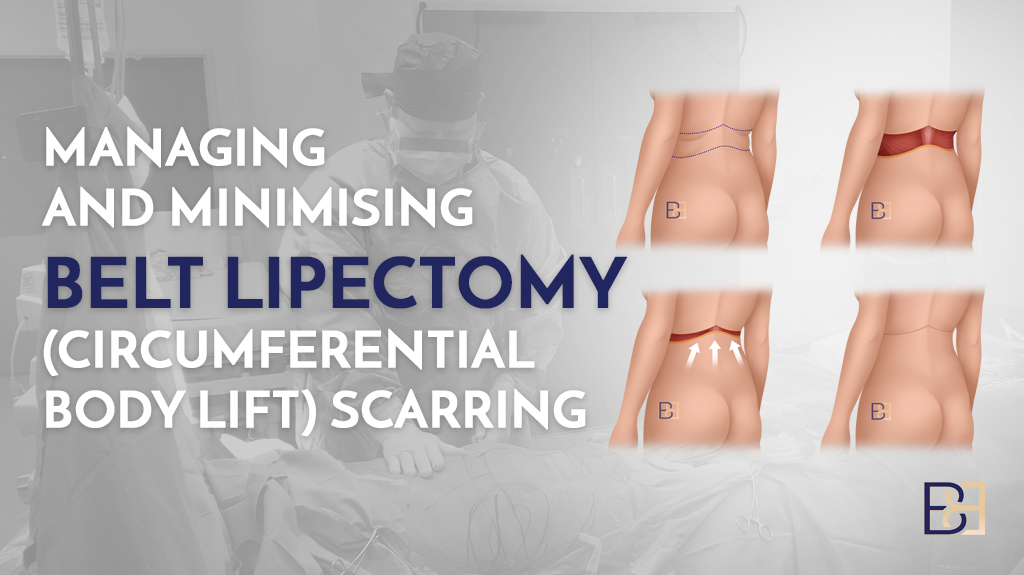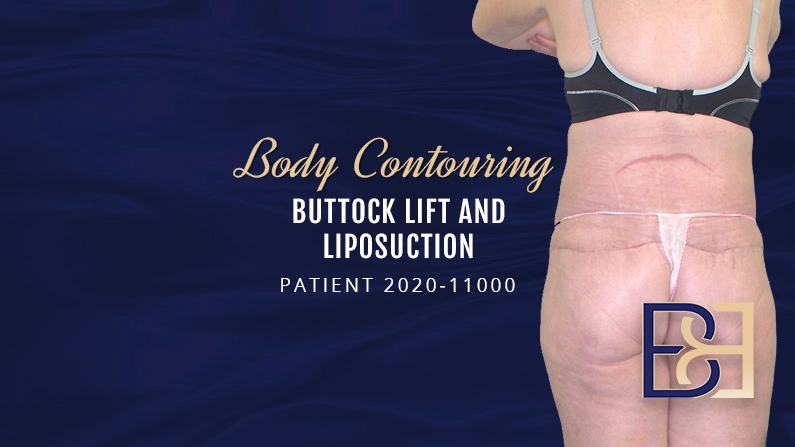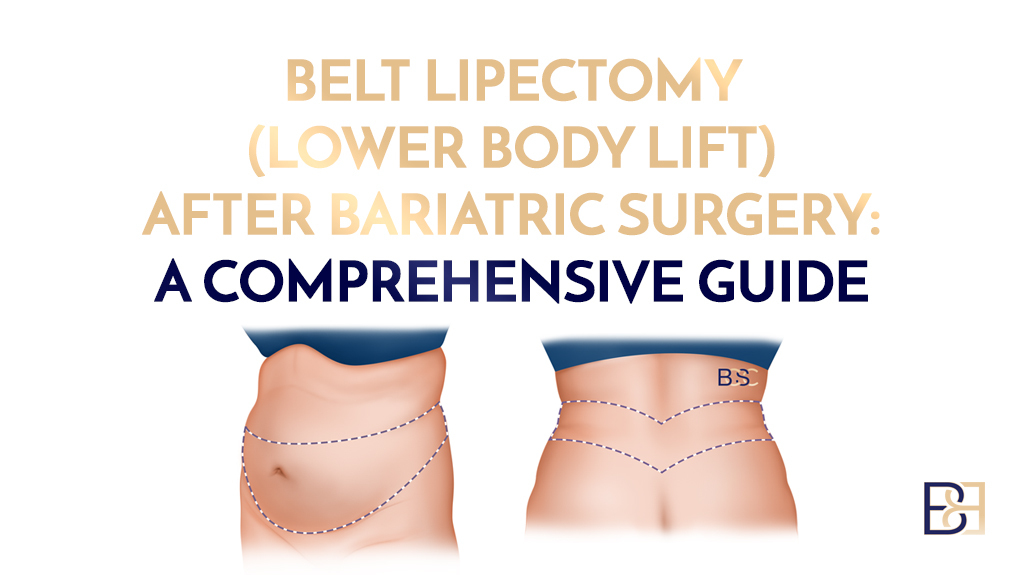In this belt lipectomy surgical guide, you’ll learn who is a candidate, how much it costs, what kind of results to expect, possible surgical risks, the length of recovery, the operation steps, and more.
What is Belt Lipectomy Surgery?
What it is: A body contouring procedure designed to remove loose skin all the way around the waist.
Who it’s for: People with loose skin after significant weight loss.
Other Names: Lower Body Lift, Circumferential Body Lift, Belt Line Surgery, 360 degree lipectomy
A lower body lift (belt lipectomy) is a body contouring surgery that removes a significant amount of loose
skin around the waistline. It’s commonly performed to correct skin excess after weight loss surgery.
Book your appointment online now
Using a 360 degree incision around the belt line of the patient’s torso, the procedure, which is sometimes referred to as a circumferential abdominoplasty, leaves the skin on the abdomen, hips, flanks, mons pubis, buttocks, and thighs appearing firm, tight, and lifted.
Fun Fact: The first belt lipectomy was performed by Dr. M. Somalo in 1940 in Argentina. Surgical techniques have become more refined since then. (Ref 1)

How Do a Belt Lipectomy and Abdominoplasty Differ?
Learn the difference between a belt lipectomy and abdominoplasty.
A belt lipectomy targets more body areas of the body than a tummy tuck (traditional abdominoplasty). The latter only removes excess skin and fat from the abdominal area, while a belt lipectomy targets the abdomen, waistline, flanks, mons pubis area, bum, and inner and outer thighs. It’s a much more complex surgery and is sometimes performed in two stages.
Who Needs a Belt Lipectomy?
For patients who have lost a lot of weight loss through bariatric surgery or dieting, the redundant skin can be extreme and affect multiple body areas. People with excess skin and fat on the Abdomen, hips, lower back, inner and outer thighs, pubic area, and buttocks may benefit from this operation.

Disclaimer: Operation performed by Dr Bernard Beldholm. Adult content, surgery has risks; individual results vary, seek 2nd opinion. Please see the full disclaimer.
Who is a Suitable Candidate for a Belt Lipectomy Procedure?
Although this surgery tightens skin drastically in many areas, the surgery is not right for everyone. You should be fairly close to your ideal weight and wait at least six months or more for your weight loss to remain stable. It’s preferred to wait at least a year after reaching a stable weight to allow time for the loose skin to shrink naturally before a belt lipectomy procedure.
Additionally, you must not be a smoker (or you must be willing to quit); be pregnant or nursing; or suffer from certain serious health problems.
Many factors affect whether a person is a good candidate for a lower body lift (belt lipectomy) surgery. A qualified specialist surgeon can tell you whether you are a good candidate, therefore the first step is to schedule a consultation. As a surgeon who specialises in post-weight-loss body contouring, I see patients interested in excess skin removal every day. It is my goal to help you decide whether this procedure is a good fit for you and if it will achieve the results you seek.
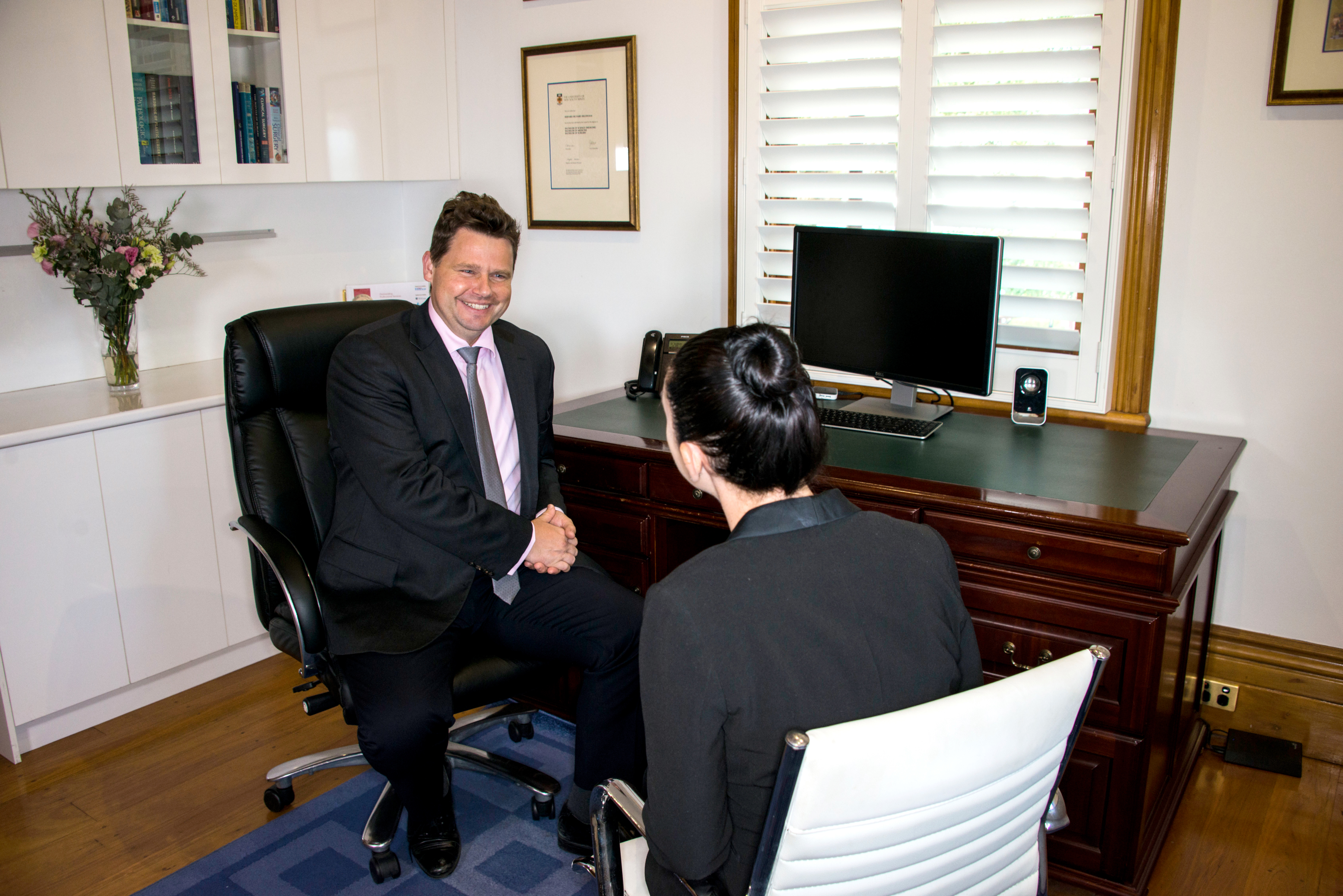
Ideal Candidates
Do not smoke.
Are not pregnant.
Are physically fit.
Have lost a significant amount of weight.
Have realistic expectations and cosmetic goals.
Have maintained a healthy weight for six months or longer.
Can take time off work and driving during the recovery period.
Have waited at least a year for the stretched skin to retract on its own.
Are willing to adopt a healthy diet and exercise routine after recovering from the surgery to maintain their results.
How Much Does a Belt Lipectomy Cost?
Average Estimated Price Range: $20,000 to 35,000 AUD
A lower body lift (belt lipectomy) is perhaps the most complex of all the body contouring procedures, several body areas at once. The surgery is therefore more costly than individual services like liposuction or a standard abdominoplasty.
The average belt lipectomy cost in Australia is more or less $20,000 to 35,000 AUD. You may be thinking that is a wide price range, and it is. The truth is, it’s difficult to give an accurate price quote until I see the patient in person. Everyone’s body is different after massive weight loss and requires a unique surgical approach.
To receive a personalised price quote, including the cost of the surgeon’s fees, anaesthetist fees, and hospital fees, please schedule a private consultation.

Will Medicare Cover a Belt Lipectomy Procedure?
Medicare will cover some of the belt lipectomy cost if the patient qualifies for an MBS item number, however, strict criteria apply. For example, the excess skin must interfere with your daily life and you must be having the surgery due to a medical need rather than for cosmetic reasons. Other rules apply, and I can tell you more about these during your consultation if you appear to qualify. The MBS Item Number for belt lipectomy is 30179. (Ref 2)
Will Private Insurance Cover a Belt Lipectomy Procedure?
Some private health funds will chip in toward the hospital charges for belt lipectomy surgery, leaving patients responsible for the remaining costs. Like Medicare, insurance requires the patient to meet the strict criteria listed in the Medicare Benefits Schedule for item number 30179.
To qualify, gold-level health coverage is usually required. Be sure to call your health fund to see what your tiered plan covers. It is possible to switch to a different health fund, but there is usually a waiting period before patients can access the plan’s benefits. The waiting period is generally a year.

Body Areas treated With a Belt Lipectomy Procedure
A belt lipectomy helps to lift, tighten, and tone the following areas.
Buttocks
Lower back
Mons pubis region
Abdomen and hips
Inner and outer thighs
During the surgery, I can also repair separated abdominal muscles (Diastasis recti), if needed.
Benefits of Belt Lipectomy
The before-and-after belt lipectomy results can be dramatic, although individual results vary depending on the patient. This surgical procedure removes more excess skin and fat than virtually any other body contouring surgery. Aside from making the skin appear smoother, tighter, and less bulky, it also may reduce skin irritation from the skin folds rubbing together.

Belt Lipectomy Consultation Process
Anyone interested in this surgical procedure should schedule a consultation with a qualified specialist surgeon (FRACS). You can schedule your consultation with me by phone or by booking online. My consultation typically goes like this:
You will come to my office in Lorn for a thorough consultation.
You will asked to fill out paperwork.
I will learn about your cosmetic goals and areas of concern.
I will perform a physical examination.
Next, I will discuss your medical history, amount of weight lost, and relevant lifestyle questions.
I’ll then create a customised surgical plan if I determine you are eligible for surgery.
Together, we will discuss the risks of surgery, how to prepare for the procedure, and review aftercare and recovery.
A few days later, you will receive a price quote for my surgical fee, anaesthetist fee, and hospital charges.
My consultation is typically an hour long and includes time to answer any questions. I charge a fee for the first consultation. Additional consultations (if needed) are not charged and I can meet with you via Zoom if you have any questions or concerns, if that’s more convenient for you.
Belt Lipectomy Risks and Complications
I’m always honest with my patients, which is why discussing the risks and complications possible with surgery is an important part of my consultation process.
In my practice, complication rates are generally quite low. However, no surgeon can rule out the possibility of something going wrong during or after surgery, no matter how careful they might be. That’s why I make sure to disclose the risks and answer any questions my patients might have regarding possible complications.
Like any operation, a belt lipectomy carries some risks. Possible belt lipectomy complications may include:
Infection
Excessive bleeding
Thick or raised surgical scars
Sutures that don’t stay in place
Wound separation (dehiscence)
Clots that may travel to the lungs
Tissue death (necrosis of the skin)
Temporary or permanent nerve damage
Bruising and haematoma formation (which may require draining)
Imperfect cosmetic results which may require a revision procedure
Excess fluid buildup at the site of the wound (which may require drainage)
Book your appointment online now
Getting Prepared for Your Belt Lipectomy Procedure
Preparing for belt lipectomy can include completing lab tests, picking up prescriptions from the pharmacy, and scheduling three to four weeks off work to recover. You should ask household members to handle driving, chores, pet and childcare, and grocery shopping during the first few weeks of healing. You will also need someone to drive you to follow-up appointments until you are cleared to resume driving. Most of my patients start driving at three to four weeks.

What Happens During Belt Lipectomy Surgery?
Markings are Drawn
I’ll start by drawing surgical markings on your body. The markings, which are drawn while you’re standing in the anaesthetic bay, are crucial to do beforehand since gravity can change how the body and excess skin look while you’re lying down on the operating table.
Anaesthetist Administers General Anaesthesia
Once you’ve been wheeled into the operating room, a licensed anaesthetist will insert an IV containing a general anaesthetic. This ensures that you will not experience pain during or have any memory after surgery.
Surgery Begins
A lower body lift operation (belt lipectomy) is a multi-step process that involves being turned over midway through the surgery.
Body Positioning
Next, you lay down on a operating table in the O.R. face down so I can work on removing excess skin from the back and buttocks first.
VASER Liposuction
Before I start to remove excess skin, I typically perform VASER liposuction (suction-assisted lipectomy) on the lower back and buttocks, if needed. This type of liposuction (suction-assisted lipectomy) not only reduces unwanted fat; It partially dissects the tissues which makes it easier to remove the excess skin later in the operation.
VASER liposuction (suction-assisted lipectomy) is unique in that it melts the fat, making it easier to remove. Once the fat becomes liquid, it is extracted through a hollow tube known as a cannulae.
Excess Skin and Fat Removal of the Buttocks and Lower Back
After the VASER liposuction (suction-assisted lipectomy) is completed, I make a horizontal incision along the lower back, using the surgical markings as a guide. The excess skin and subcutaneous fat are then cut off. I cauterise each blood vessel as I go to decrease bleeding, bruising, and discomfort in recovery.
After removing the loose skin and attached fat, the skin is pulled together tightly at the incision line. This lifts and smooths the skin on the buttocks and lower back areas.
Closing the Incision
I close the incision in layers. Permanent sutures go into the deeper tissues, followed by three layers of barbed sutures. Medical-grade tissue sealant (a sprayable glue) is applied to ensure all the layers are properly and thoroughly sealed.
Turning Over
My operating room staff and I will carefully turn you over on the table so I can work on the front regions. Turning is a very slow and careful process that can take up to an hour.
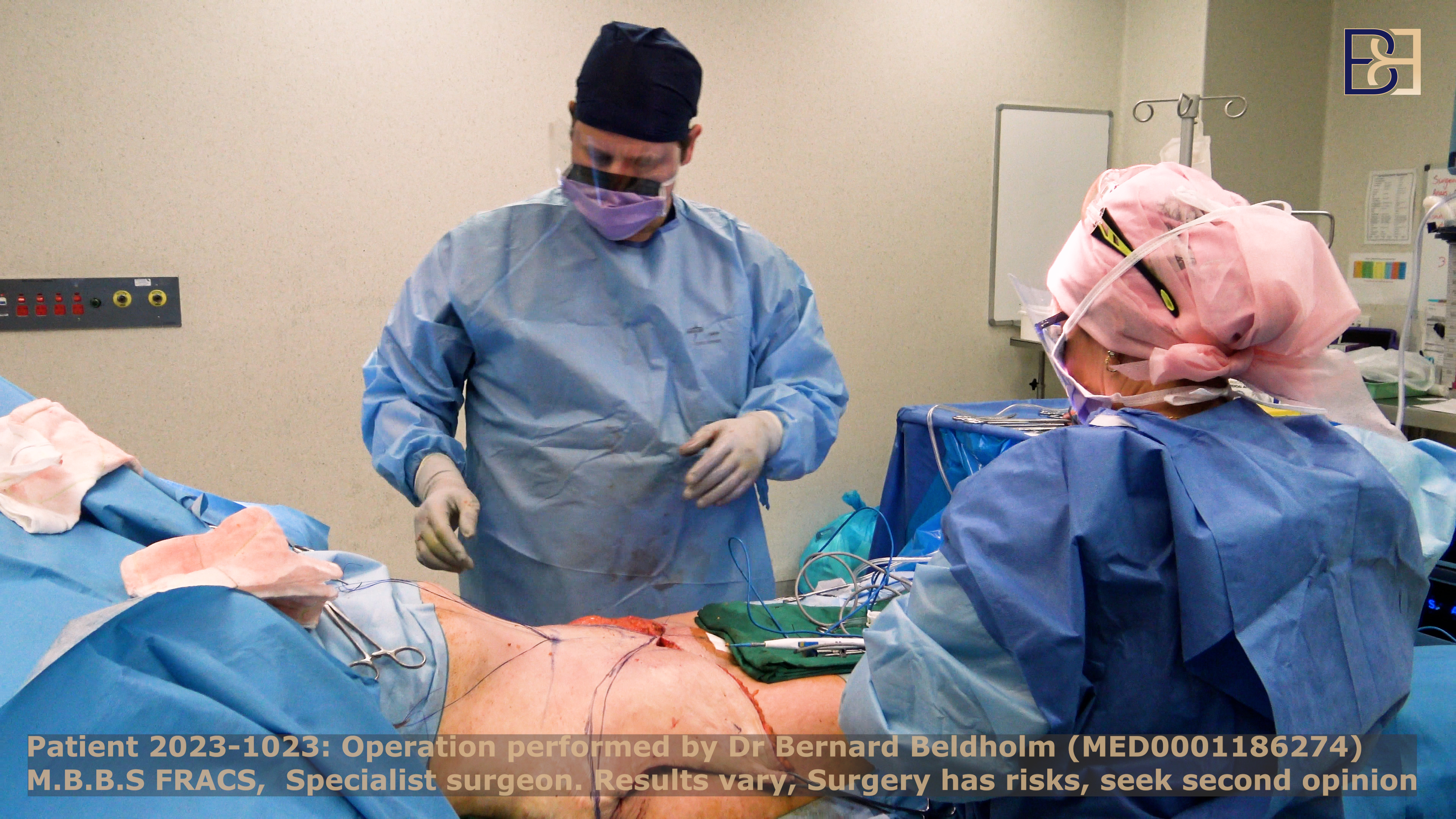
Extended Extended Abdominoplasty with VASER Liposuction (suction-assisted lipectomy)
The next steps, which are similar to that of a standard tummy tuck (Abdominoplasty) with an elongated incision that goes across the lower abdomen and around the hips, involve VASER liposuction to remove fat from the abdomen.
Next, I will free the navel with a small incision. This allows me to remove the excess skin and pull the skin up freely.
After making the incision, I dissect the tissues and create a tunnel to access the six-pack muscles, which are pulled together gently with sutures if there is muscle separation. Now it is time to remove the hanging apron of skin from the lower belly. I carefully measure how much skin to remove. This is easier when the operating table is on a slight tilt, which helps me visualise how the skin will drape once the excess is removed.
Once the extra skin and attached fat are removed, I pull the lower part of the incision upward. This also has a smoothing effect on the mons area and also helps to lift and smooth the inner and outer thighs.
Umbilicus Repositioning
To ensure the Umbilicus doesn’t sit too low once the incision is pulled closed, I create a new hole for the navel and pull the patient’s navel stalk through it. The navel is sutured in place. I also spray tissue sealant.
Closing the Incision
Finally, I close the abdominoplasty incision. Again, I work in layers by applying 2/0 vicryl sutures deep down, followed by absorbable barbed sutures more superficial. The tissue spray sealant helps to keep everything in place for nice, tight closure.
PICO Wound Dressings Applied
Next, I apply PICO negative pressure dressings on the incision. This is a soft bandage attached to a battery pack that applies negative pressure to lower the risk of infection. (Ref 3) My patients are instructed to wear the PICO dressing for seven days.
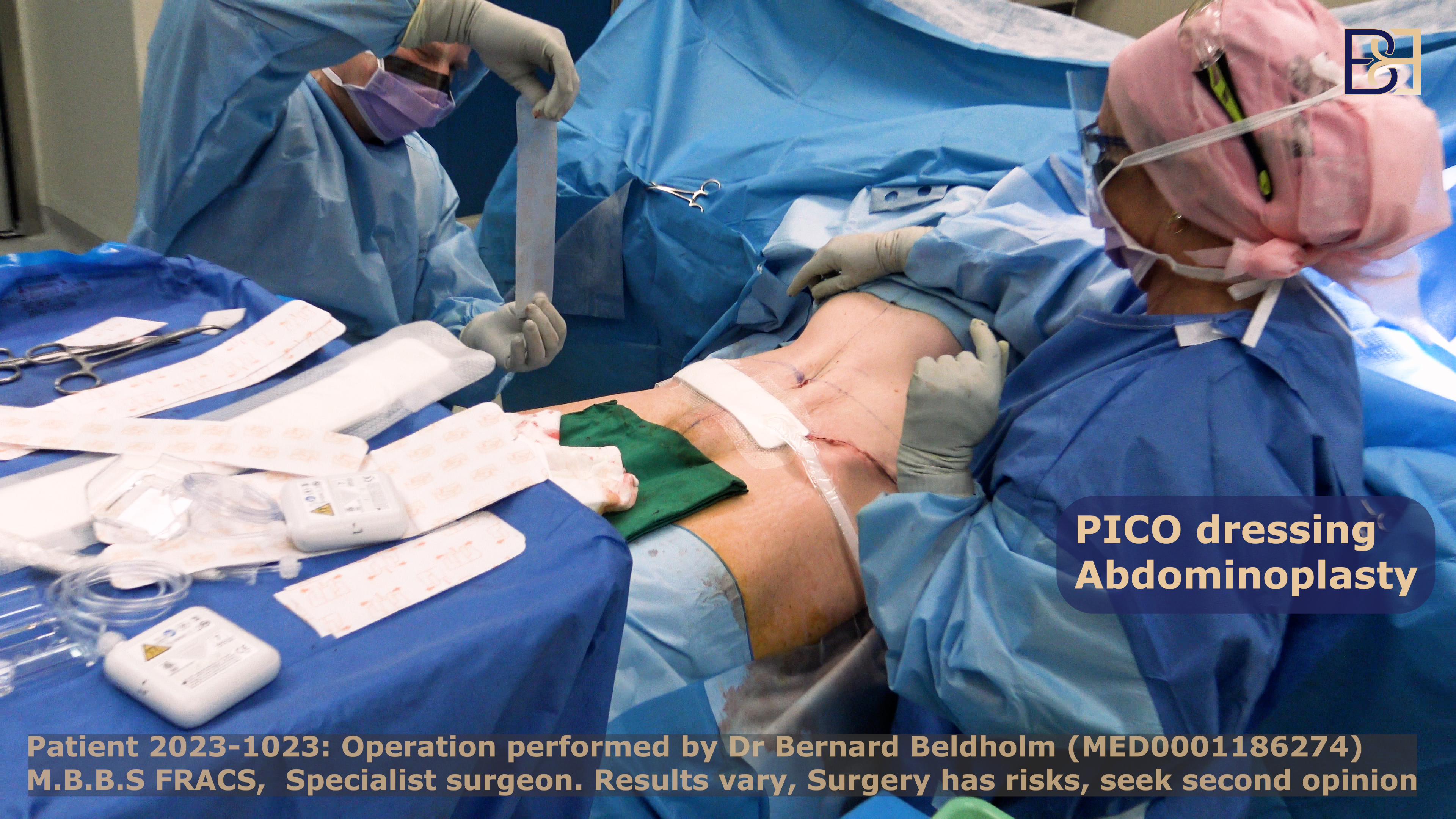
Compression Garment Applied
Finally, a compression garment, which reduces swelling and lowers the chance of issues like seroma, is applied. You will be instructed to wear the compression garments for several weeks.
Length of Belt Lipectomy Surgery
Belt lipectomy takes several hours to perform, though the actual extent of the surgery varies from patient to patient. In general, plan on being in the O.R. for approximately six to seven hours.
Belt Lipectomy Recovery
Hospital Stay
Most patients will remain in the hospital for five to seven days following lower body lift surgery (belt lipectomy).

Recovery Timeline
Most patients start feeling more like themselves after three to four weeks, but it can take three months or longer for complete healing to occur.
Day 1
Expect to feel groggy since it can take up to 24 hours for the effects of the general anaesthetic to wear off. Soreness and swelling tend to peak in the first few days. I’ll check in with you to see how you’re feeling after surgery. You’ll remain in the hospital and won’t be discharged until five to seven days later.
Week 1
You’ll spend five to seven days in the hospital when swelling and discomfort can be significant. You will be able to walk slowly and bend at the waist with assistance. Walking is essential to avoid a blood clot in the legs.
Week 2
You should be ready to return home after spending up to a week in the hospital. Someone will need to drive you and help you into and out of the car. You can take a bird bath, but avoid getting the PICO wound dressing and battery pack wet. Like most surgeons, I advise avoiding strenuous activities, but I will encourage you to take light walks.
Remember to take all medications as prescribed to stay ahead of the pain. Seven to nine days after surgery, someone will need to drive you to my office for a follow-up appointment. During this visit, I’ll replace the PICO wound dressing with Hypafix tape which can get wet. You can take a full shower after this.
Weeks 3-5
After 14 days, most of my patients are cleared for light exercise. You’ll want to avoid physical exertion and heavy lifting, but light aerobics and walking are okay. While some of the soreness should taper off by this time, you may have some numbness. If you feel up to it, you can begin driving at weeks three to four and return to light work duties. Discomfort and swelling should continue resolving with each passing week.
Weeks 6-8
You can increase your physical activity to include weight lifting, jogging, and intense aerobics. Swelling and discomfort are usually greatly diminished by now. Numbness and shooting nerve pains can sometimes last up to three months.
Month 3
At this point, you should be feeling more like yourself. Nearly 60 percent of the swelling has subsided. Numbness and firmness in the treated areas should settle down by now. What you see at this stage is not your final result, but you are getting closer.
Months 6-12
With nearly all the swelling resolved, you should have a better idea of your final results.
Months 12-18
A year after your surgery, your final results will be apparent. Visible scars are a fact of life after surgery. You will have a circumferential scar around your waistline, but it should fade substantially after 12 to 18 months and be well-hidden in most clothing styles.
Recovery Guidelines
Here is a general overview of what to expect as you heal.
Driving After Lower Body Lift (Belt lipectomy)
I advise my patients to wait at least three to four weeks before driving. Someone (usually a family member) must drive you home from the hospital and bring you back for your follow-up visit.
Returning to Work After Lower Body Lift
You should be able to return to work three to four weeks after surgery if you have a sedentary job such as office work. Those with physically demanding jobs that require heavy lifting or physical exertion may need approximately six weeks or longer off from work.
Resuming Exercise Routine After Lower Body Lift (Belt lipectomy)
Walking can be challenging during the first week or so, though it will get easier with time. As such, you will need to start slowly while bending lightly at the waist during the first ten days or so. While it can feel awkward or a bit painful, it is very important to walk soon after surgery to lower the risk of blood clots. A clot in the legs can travel to the lungs causing pulmonary embolism, which is a life-threatening condition.
While light walking is encouraged, strenuous exercise must be avoided for several weeks after surgery. Light exercise can begin at two weeks in most cases. Most patients are cleared to return to their full exercise routine, including jogging and weight lifting, after six to eight weeks.
Lower Body Lift (Belt lipectomy) Incision Aftercare
Proper incision care lowers the risk of infection and gives the greatest chance of a nice-looking surgical scar. The wound should be kept clean until it heals. My staff and I will provide you with thorough aftercare instructions.
Showering After Lower Body Lift (Belt lipectomy)
You won’t be able to take a full shower until I remove the PICO wound dressing since the battery attached to it can’t get wet. I usually remove the PICO dressing seven to nine days after the operation. Until then, you can take sponge baths if needed, being extremely careful not to allow the PICO dressing or battery to get wet.
Swelling After Lower Body Lift (Belt lipectomy)
Expect significant swelling in the first few days and weeks after the operation. This gets better with time. Most of the swelling and firmness subsides after 12 weeks, with all the swelling resolving after 6 to 12 months.
Lower Body Lift (Belt lipectomy) Pain Management
Patients should prepare for some bruising, discomfort, and numbness. Though pain will be significant during the first few days, it should be manageable with pain medications. Note: If pain worsens or persists despite medication, please contact my office immediately to rule out complications.
Sleeping After Lower Body Lift (Belt lipectomy)
I instruct all of my patients to sleep on their backs with their heads propped on pillows, with the waist slightly bent, as this is the most comfortable sleeping position during the initial recovery period.
Book your appointment online now
FAQs
How long is the belt lipectomy scar?
A true circumferential lower body lift (Belt lipectomy) scar goes completely around the waistline. Sometimes the scar only goes around the front and sides of the waistline, stopping at the flanks. It all depends on how much and where the patient has excess skin. I’ll explain what kind of scar to expect during the consultation, as each patient is unique.
Does Medicare cover a belt lipectomy?
Those with gold-level coverage may have some of the hospital cost covered, but only if they qualify for the MBS item number for lower body lift surgery (circumferential belt lipectomy).
How much does a belt lipectomy (lower body lift) cost in Australia?
Pricing depends on the individual patient’s surgical plan, surgeon fees, length of hospital stay, the variable cost of anaesthesia, and other factors. Generally speaking, costs can range from $20,000 to $35,000 with some patients paying more and others paying less. You will receive a custom price quote a few days after our consultation. Call my office on (02) 4934-5700 or book online to arrange a consultation.
Is a belt lipectomy risky?
Risks are possible and may include infections, poor scarring, asymmetrical surgical results, wound breakdowns, blood clots, pulmonary embolism, adverse reactions to general anaesthetic, etc. It is a major surgery and therefore carries a higher chance of complications than other less invasive surgical procedures. Complication rates are higher when paired with other procedures. Therefore, other services like breast lift surgery (mastopexy) or an upper body lift should not take place the same day.
Is it possible to have a belt lipectomy and liposuction (suction-assisted lipectomy) at the same time?
I often perform VASER liposuction (suction-assisted lipectomy) during my belt lipectomy surgeries. I find it makes the dissection easier and helps remove stubborn fat pockets for a more aesthetically refined result.
Will this procedure help me reach my ideal weight?
A belt lipectomy with liposuction (suction-assisted lipectomy) will remove excess fat and remaining skin after losing a significant amount of weight. However, it is not a substitute for weight-loss surgery or a healthy lifestyle. You’ll need to reach a reasonably healthy weight before the operation.
Medical References
“International Contributions to the History of Plastic Surgery.” ISAPS, www.isaps.org/es/discover/about-isaps/history/international-contributions-to-the-history-of-plastic-surgery/. Accessed 5 May 2024.
“Item 30179 | Medicare Benefits Schedule.” Www9.Health.gov.au, www9.health.gov.au/mbs/fullDisplay.cfm?type=item&q=30179&qt=item. Accessed 6 May 2024.
PICO Negative PICO Negative Pressure Wound Dressings E Pressure Wound Dressings for Closed Surgical Incisions for Closed Surgical Incisions Medical Technologies Guidance. 2019.


